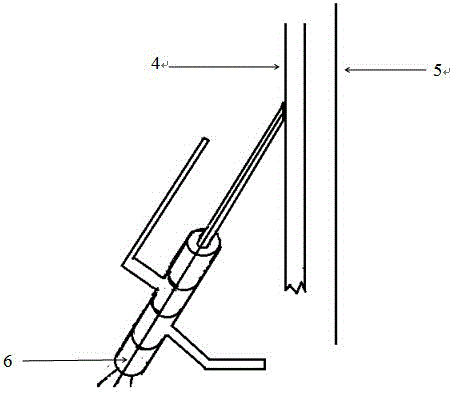Phalangeal fracture kirschner wire internal fixation guider and using method thereof
A phalanx fracture and Kirschner wire technology, which is applied in the field of Kirschner wire guide devices, can solve the problems of high probability of soft tissue iatrogenic injury, high requirements for experience and physical strength, and low success rate of one-time needle penetration, so as to improve the accuracy of one-time needle penetration. The effects of needle success rate, shortened operation time, and reduced dependence on physical strength and experience
- Summary
- Abstract
- Description
- Claims
- Application Information
AI Technical Summary
Problems solved by technology
Method used
Image
Examples
Embodiment 1
[0027] A Kirschner wire internal fixation guide for phalanx fractures, which includes a hollow guide wire direction pointer and a handle; above the guide hollow needle, there is a direction pointer parallel to it, and the direction pointer and the handle are connected with the hollow guide wire in the form of a sleeve. Connected, the direction pointer and the handle can rotate around the longitudinal axis of the guide pin, the purpose of which is to facilitate operation in different parts, wound positions and shapes, skin soft tissue conditions, and fracture conditions. The inclined surface at the distal end of the hollow guide wire can make the Kirschner wire drill holes stably on the smooth inner wall of the bone marrow cavity; in addition, the direction pointer can be used to pre-judge the needle position before the Kirschner wire is inserted, so as to avoid repeated needle insertion. Soft tissue injury.
Embodiment 2
[0029] How to use the Kirschner wire internal fixation guide for phalangeal fractures: insert the tip of the guide wire into the medullary cavity of the fracture end, judge the exit point of the Kirschner wire according to the direction pointed by the direction pointer, and adjust the position and position of the guide wire accordingly. After completion, stick the smooth tip of the guide wire on the inner wall of the medullary cavity, insert the Kirschner wire from the tail end of the guide, and drill into the Kirschner wire. In this way, the position of the needle can be pre-judged before the Kirschner needle is inserted, so as to avoid soft tissue damage caused by repeated needle insertion.
Embodiment 3
[0031] Conventional Kirschner wire internal fixation method for phalanx fracture: a case of open fracture of the proximal phalanx of the index finger, the same doctor performed the operation, exposed the fracture end after debridement, and drilled the Kirschner wire retrogradely into the cortex of the distal part of the fracture According to the operator's experience and anatomical knowledge, the point of needle exit is determined and the tip of the Kirschner wire is drilled at an angle of about 30-40° to the cortical bone, and the other end of the Kirschner wire is withdrawn from the fracture line to perform fracture reduction. After the reduction is satisfactory, the Kirschner wire is drilled back in the opposite direction to fix the contralateral cortex, thus completing the entire Kirschner wire internal fixation process.
[0032] Results: During the operation, the Kirschner wire slipped and adjusted many times, and the angle of the needle was adjusted many times, so a total...
PUM
 Login to View More
Login to View More Abstract
Description
Claims
Application Information
 Login to View More
Login to View More - R&D
- Intellectual Property
- Life Sciences
- Materials
- Tech Scout
- Unparalleled Data Quality
- Higher Quality Content
- 60% Fewer Hallucinations
Browse by: Latest US Patents, China's latest patents, Technical Efficacy Thesaurus, Application Domain, Technology Topic, Popular Technical Reports.
© 2025 PatSnap. All rights reserved.Legal|Privacy policy|Modern Slavery Act Transparency Statement|Sitemap|About US| Contact US: help@patsnap.com


